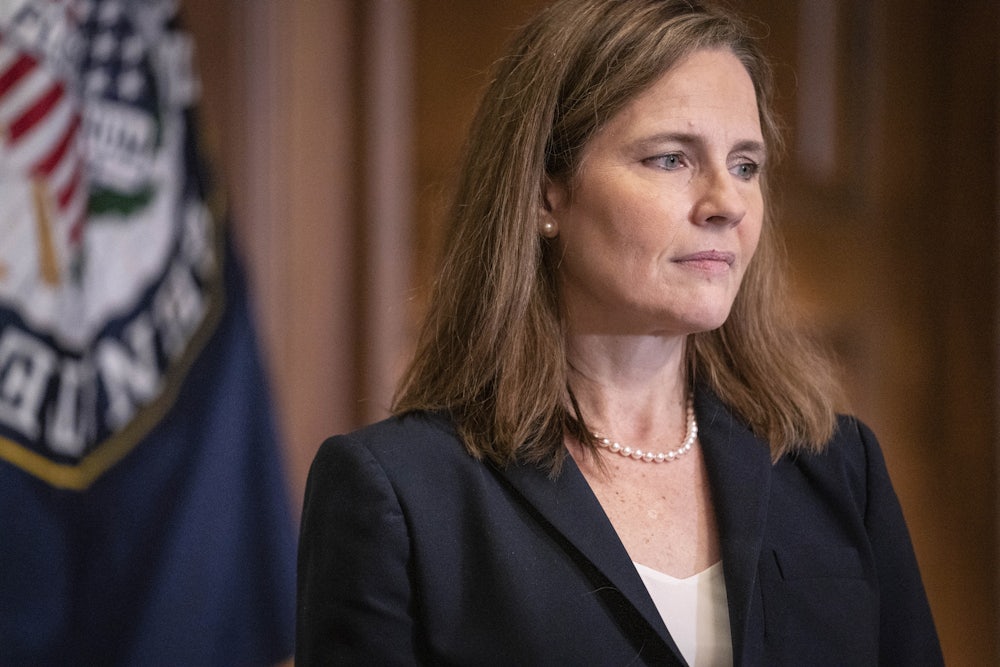On November 4, the Biden administration announced a new testing mandate for unvaccinated workers in most American companies. As with everything else in American life these days, litigation soon followed from conservative business owners and Republican officials. The Fifth Circuit Court of Appeals was the quickest to respond to the proposed Occupational Safety and Health Administration rule and issued a stay of its enforcement. These stays aren’t necessarily unusual, but in this case, there was something a little different about it.
“Because the petitions give cause to believe there are grave statutory and constitutional issues with the Mandate, the Mandate is hereby stayed pending further action by this court,” the three-judge panel wrote to explain its decision. Some legal experts noted right away that this order doesn’t actually apply the usual judicial test for courts to provide emergency relief. Instead, it blandly asserts that there is “cause to believe” the proposed rule might be illegal and constitutional.
It also didn’t escape notice that this was the same panel—the exact same trio of Fifth Circuit judges—who not only refused to block Texas’s controversial abortion bounty law from going into effect while lawsuits unfolded but also went out of its way to torpedo a lower-court order that had blocked it from being enforced. That judicial gambit paid off when the Supreme Court, by a 5–4 vote, decided not to overturn the Fifth Circuit’s maneuver in that case. As a result, Senate Bill 8 remains in effect unless and until the Supreme Court says otherwise.
The moment is useful for illustrating a subtle but important shift in the federal judiciary—and how people view the federal judiciary—over the past 18 months. Naturally, Justice Amy Coney Barrett’s confirmation shifted the court decisively to the right. But the perception of the Supreme Court’s ideological balance is almost as important as the reality itself. Now that this perception has taken root, we’re starting to see it bear fruit. Call it the Barrett effect: A variety of conservative political actors are now doing things they might have hesitated to consider when Chief Justice John Roberts or former Justice Anthony Kennedy cast the deciding vote. This dynamic, in turn, is poised to push the country even further to the right.
Perhaps the most high-profile instance of this effect came in Dobbs v. Jackson Women’s Health Organization. The case involves a Mississippi law that bans virtually all abortions performed after 15 weeks, defying Roe v. Wade’s general protection of the procedure before fetal viability. When the state of Mississippi first asked the Supreme Court to take up the case in March 2020, it insisted that the court could actually uphold the law without revisiting Roe or Planned Parenthood v. Casey, the 1992 case that rewrote its central holdings. The justices agreed to hear the case earlier this spring.
When Mississippi filed its briefs a few months ago, however, it changed its tune. The state is now making a forceful and direct argument for the court to overturn Roe v. Wade altogether, writing that “nothing in constitutional text, structure, history, or tradition supports a right to abortion” and that the justices should use the case to correct what it saw as a half-century-old judicial error. The Supreme Court’s precedents did not actually change in the intervening 18 months; indeed, the court had just issued a ruling in 2020 that struck down an anti-abortion law in Louisiana. All that had changed was the court itself: Ruth Bader Ginsburg died in September 2020, and the Senate confirmed Barrett to replace her the following month.
When new justices join the court, it can upend long-standing equilibriums. The Trump era, which saw three justices replaced in a span of four years, was particularly disruptive. Until recently, abortion rights groups could be relatively confident that Anthony Kennedy, who voted to save and rewrite Roe in Casey in the 1990s, would not provide a fifth vote to overturn the ruling. LGBT rights advocates who had persuaded him to rule against Texas sodomy laws and the federal Defense of Marriage Act in 2013 had good reason to believe he would strike down same-sex marriage bans in Obergefell v. Hodges. Conservative and liberal legal activists alike saw him as persuadable and tailored their strategies accordingly.
Kennedy’s retirement shifted the focus to Chief Justice John Roberts as the new median vote. Then, while the country adjusted to that change, Barrett’s confirmation upended it completely. Her replacement of Ginsburg marked one of the sharpest ideological shifts in a Supreme Court seat in the last 30 years. But it’s her effect on the court’s overall ideological balance that is truly seismic. Indeed, an earthquake’s magnitude is measured logarithmically: A 6.0 earthquake is 10 times as powerful as a 5.0 earthquake. The same can be said about the high court’s conservative bloc when it went from five justices to six.
Consider how the Roberts court operated until recently. The court’s four liberals regularly found themselves in the majority by peeling off one conservative justice’s vote in certain cases, usually Anthony Kennedy’s but occasionally Roberts’s or one of the others’. From time to time, as in the court’s 2014–2015 and 2015–2016 terms, the result could superficially look like the liberals were in control. In just those two years, the court established marriage equality as a constitutional right, rejected a major challenge to the Affordable Care Act, struck down a Texas law that targeted abortion clinics, and brushed aside a long-running effort to end affirmative action in college admissions.
But these rulings, as others have noted, are often better understood as right-wing defeats by overreach rather than left-wing victories by persuasion. In some cases, a Supreme Court with five conservative justices may hesitate to strike down an affirmative-action program or resist calls to enshrine anti-LGBT discrimination into law. A Supreme Court with five liberal justices probably wouldn’t even consider those questions in the first place. It might instead be debating how narrowly to read the Second Amendment’s individual right to bear arms, how far the courts can go when limiting partisan gerrymandering, and whether the modern death penalty is incompatible with the Eighth Amendment’s ban on cruel and unusual punishment.
With six justices in a single ideological bloc, the calculus changes dramatically, especially for conservative and liberal legal activists. The Supreme Court no longer has a clear “swing vote,” as it did under Sandra Day O’Connor, Kennedy, and briefly Roberts. A conservative legal activist who comes before the court no longer needs a clean sweep of all five conservative justices to prevail. They can afford to lose someone perceived as squishy like Roberts and still win, as shown by the court’s 5–4 decision not to block enforcement of S.B. 8 while it heard the case. Liberal legal activists and groups, by comparison, now have to win over two conservative votes to have a shot at victory.
All of this talk of votes might sound more legislative than judicial, and some legal scholars have suggested the Supreme Court functions more like a super-legislature than a mere court of last resort. I won’t dive into that debate except to note that there are two important distinctions between the two branches. Those distinctions help shed further light on the Barrett effect: how political actors adjust their actions and expectations based on the composition of the Supreme Court and how they occasionally get it wrong.
One factor is that, for various ethical reasons, the justices can’t and won’t say how they will vote in specific cases in advance. Lawmakers are not only able to spell out their views in advance, they are expected to do so when running for office. The other factor is that the Supreme Court does not decide exactly which cases it, well, decides. While any member of Congress can write any bill they like, the justices can only hear cases that are brought before them by other parties. Even then, they can only hear a case if at least four of the justices vote to hear it.
Of course, Americans don’t live behind John Rawls’s veil of ignorance when it comes to the Supreme Court. We can—and often do—make inferences from how certain justices have voted in past cases that involve similar issues, especially on matters like abortion or gun rights. We know that some of the justices explicitly identify with certain schools of judicial interpretation that, in theory, make outcomes more predictable. Even the court’s docket is somewhat malleable: Some justices occasionally write concurring or dissenting opinions that suggest the court should reconsider some issue or precedent in a future case—a flare gun of sorts for legal activists and lower-court judges. (Justice Clarence Thomas, who’s been firing flares into the sky over his colleagues’ reluctance to take up a Second Amendment case, finally got his wish granted this year.)
All of this means that external observers of the court have just enough knowledge to make educated guesses about how the court might rule in certain cases but not enough knowledge to predict the vast majority of outcomes with absolute certainty. The desire to close that gap is so intense that the justices’ every move is closely scrutinized by lawyers, activists, and journalists. It’s why the White House and the Senate exhaustively study every square inch of a would-be justice’s writings and public statements during the confirmation process. And it’s why windows into the justices’ innermost thinking are so prized that top law firms regularly lure away former Supreme Court clerks to work in the Big Law arena with $400,000 starting bonuses.
This dynamic affects not just how the justices see each other—even they don’t necessarily know exactly how their colleagues will view a specific case—but also how everyone else sees the court. In some instances, a feedback loop forms: Litigants’ strategies influence cases, cases influence justices, justices influence rulings, and rulings influence litigants’ strategies. (This is blunt and oversimplified but hopefully helpful for illustrative purposes.) By perceiving the court as more conservative, right-wing activists and actors bring cases and controversies before the court that make it more conservative.
But that loop only works until it doesn’t. Supreme Court justices are human beings, not just ideological avatars or partisan machines, and they can surprise folks. Conservatives were stunned in 2020 when Justice Neil Gorsuch led the court to rule that Title VII’s ban on sex discrimination protects gay and transgender workers. That same term, Roberts defied expectations by voting to strike down a state law restricting abortion for the first time. And even some liberal observers were surprised to find themselves on the same side as Justice Clarence Thomas in a ruling that upheld the Affordable Care Act. By shooting for the stars and landing on the moon, those same right-wing activists and actors can occasionally make the court seem more liberal than it actually is.
Even Barrett isn’t immune to the Barrett effect. When the court heard Fulton v. City of Philadelphia last term, many court-watchers expected that the conservative justices, perhaps including Barrett, would overturn a major 1990 precedent that limits certain types of Free Exercise Clause claims. Instead the court declined to do so and issued a narrower ruling, with Barrett writing a concurring opinion that laid out why she wouldn’t go as far as the plaintiffs had hoped. At oral arguments in the S.B. 8 case earlier this month, Barrett and Kavanaugh both had tough questions for the law’s defenders. Make no mistake, this is a deeply conservative court. But whether it’s as conservative as some Texas state lawmakers and Fifth Circuit judges think it is remains to be seen.










